Analysis of Osteoporosis: A Clinical Nutrition Case Study Approach
VerifiedAdded on 2023/06/15
|5
|1062
|108
Case Study
AI Summary
This case study analyzes Brenda, a 54-year-old female at high risk for osteoporosis, focusing on the importance of patient education and dietary interventions. Brenda's condition, marked by a dowager's hump and vertebral fractures, is further complicated by a family history of osteoporosis and a reluctance to consume dairy products. The analysis emphasizes the need for patient education on the disease's progression, the significance of calcium intake for bone health, and the benefits of dairy consumption, supplemented with Vitamin D, to mitigate fracture risks. It concludes that lifestyle changes, including a balanced diet and regular exercise, are crucial in managing osteoporosis in middle-aged women. Desklib offers similar solved assignments and study resources for students.
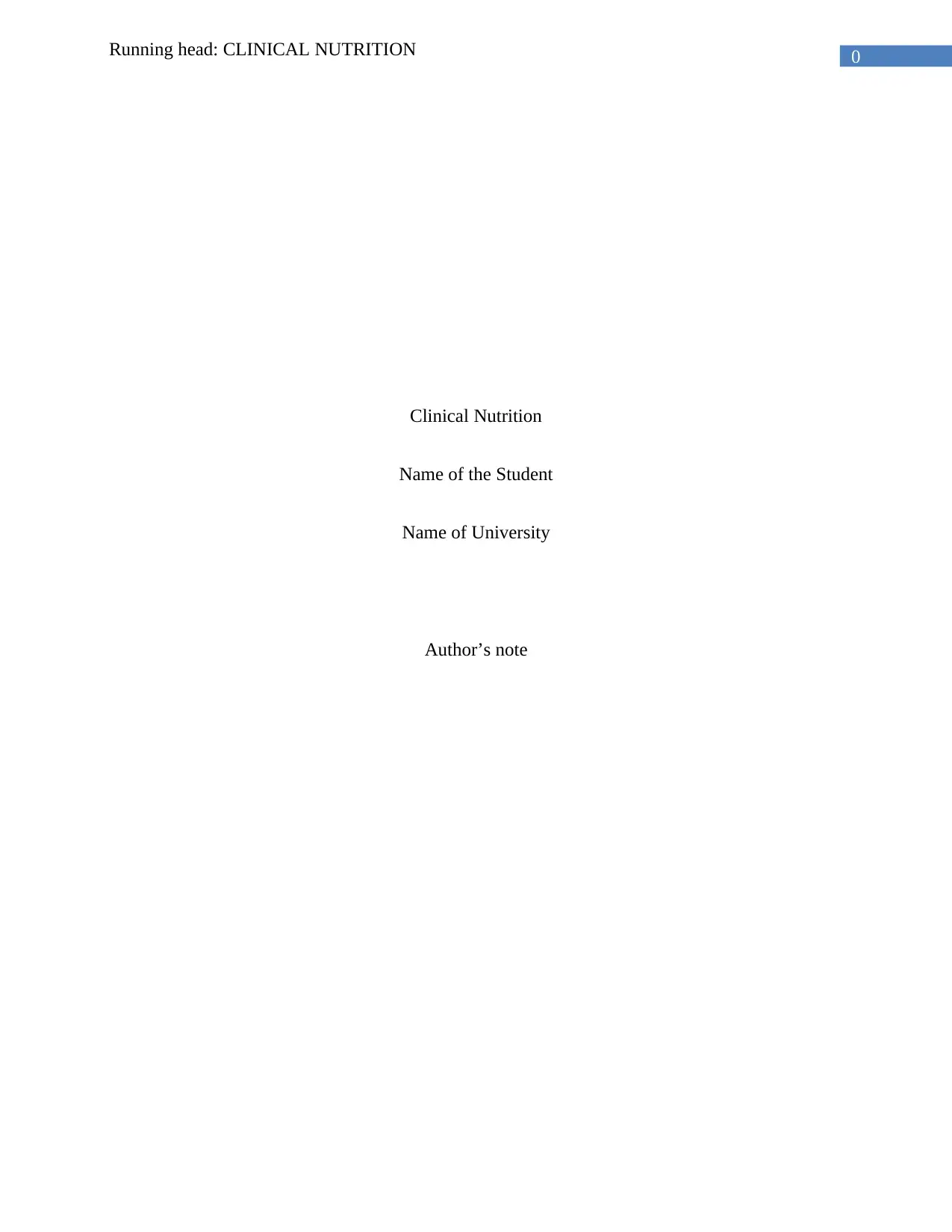
0Running head: CLINICAL NUTRITION
Clinical Nutrition
Name of the Student
Name of University
Author’s note
Clinical Nutrition
Name of the Student
Name of University
Author’s note
Paraphrase This Document
Need a fresh take? Get an instant paraphrase of this document with our AI Paraphraser
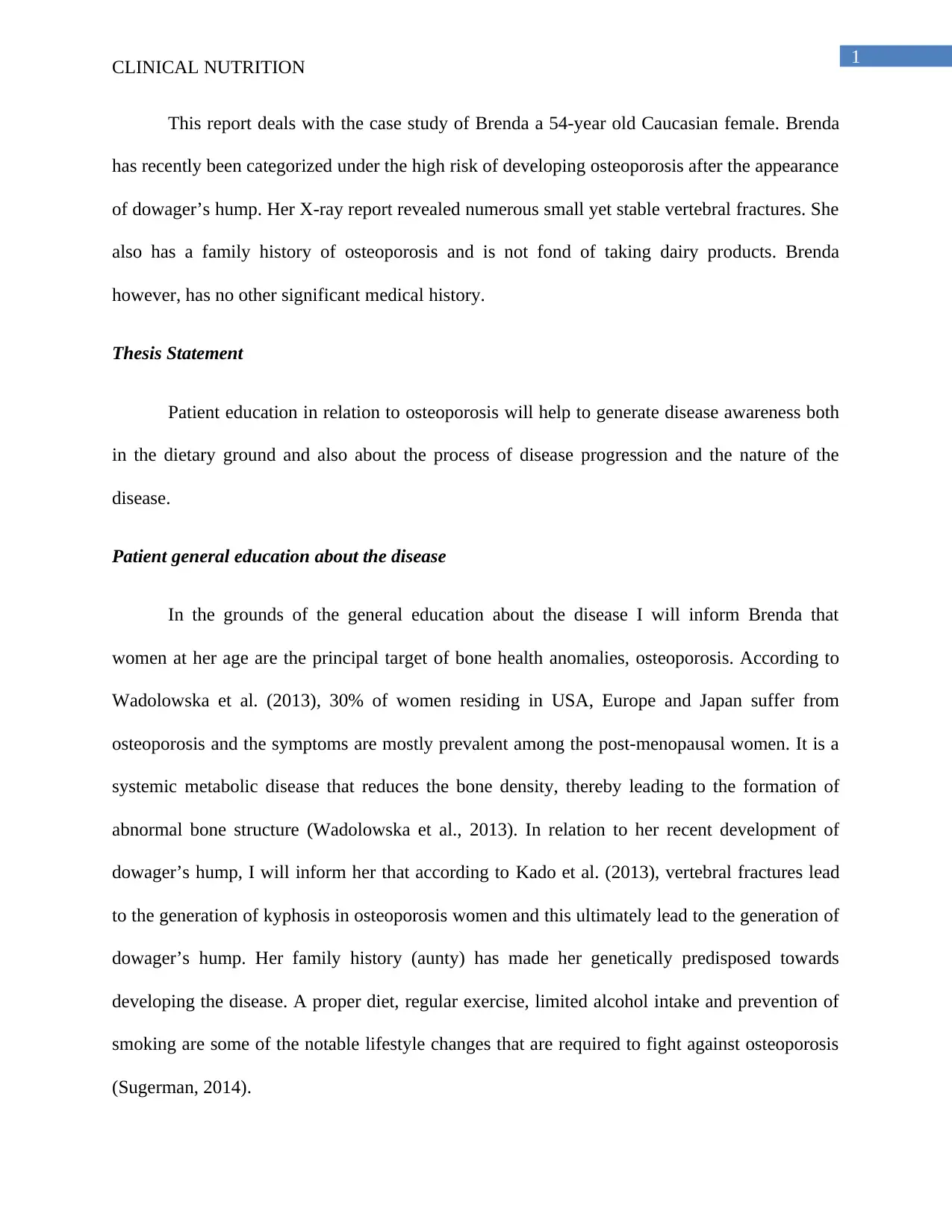
1
CLINICAL NUTRITION
This report deals with the case study of Brenda a 54-year old Caucasian female. Brenda
has recently been categorized under the high risk of developing osteoporosis after the appearance
of dowager’s hump. Her X-ray report revealed numerous small yet stable vertebral fractures. She
also has a family history of osteoporosis and is not fond of taking dairy products. Brenda
however, has no other significant medical history.
Thesis Statement
Patient education in relation to osteoporosis will help to generate disease awareness both
in the dietary ground and also about the process of disease progression and the nature of the
disease.
Patient general education about the disease
In the grounds of the general education about the disease I will inform Brenda that
women at her age are the principal target of bone health anomalies, osteoporosis. According to
Wadolowska et al. (2013), 30% of women residing in USA, Europe and Japan suffer from
osteoporosis and the symptoms are mostly prevalent among the post-menopausal women. It is a
systemic metabolic disease that reduces the bone density, thereby leading to the formation of
abnormal bone structure (Wadolowska et al., 2013). In relation to her recent development of
dowager’s hump, I will inform her that according to Kado et al. (2013), vertebral fractures lead
to the generation of kyphosis in osteoporosis women and this ultimately lead to the generation of
dowager’s hump. Her family history (aunty) has made her genetically predisposed towards
developing the disease. A proper diet, regular exercise, limited alcohol intake and prevention of
smoking are some of the notable lifestyle changes that are required to fight against osteoporosis
(Sugerman, 2014).
CLINICAL NUTRITION
This report deals with the case study of Brenda a 54-year old Caucasian female. Brenda
has recently been categorized under the high risk of developing osteoporosis after the appearance
of dowager’s hump. Her X-ray report revealed numerous small yet stable vertebral fractures. She
also has a family history of osteoporosis and is not fond of taking dairy products. Brenda
however, has no other significant medical history.
Thesis Statement
Patient education in relation to osteoporosis will help to generate disease awareness both
in the dietary ground and also about the process of disease progression and the nature of the
disease.
Patient general education about the disease
In the grounds of the general education about the disease I will inform Brenda that
women at her age are the principal target of bone health anomalies, osteoporosis. According to
Wadolowska et al. (2013), 30% of women residing in USA, Europe and Japan suffer from
osteoporosis and the symptoms are mostly prevalent among the post-menopausal women. It is a
systemic metabolic disease that reduces the bone density, thereby leading to the formation of
abnormal bone structure (Wadolowska et al., 2013). In relation to her recent development of
dowager’s hump, I will inform her that according to Kado et al. (2013), vertebral fractures lead
to the generation of kyphosis in osteoporosis women and this ultimately lead to the generation of
dowager’s hump. Her family history (aunty) has made her genetically predisposed towards
developing the disease. A proper diet, regular exercise, limited alcohol intake and prevention of
smoking are some of the notable lifestyle changes that are required to fight against osteoporosis
(Sugerman, 2014).
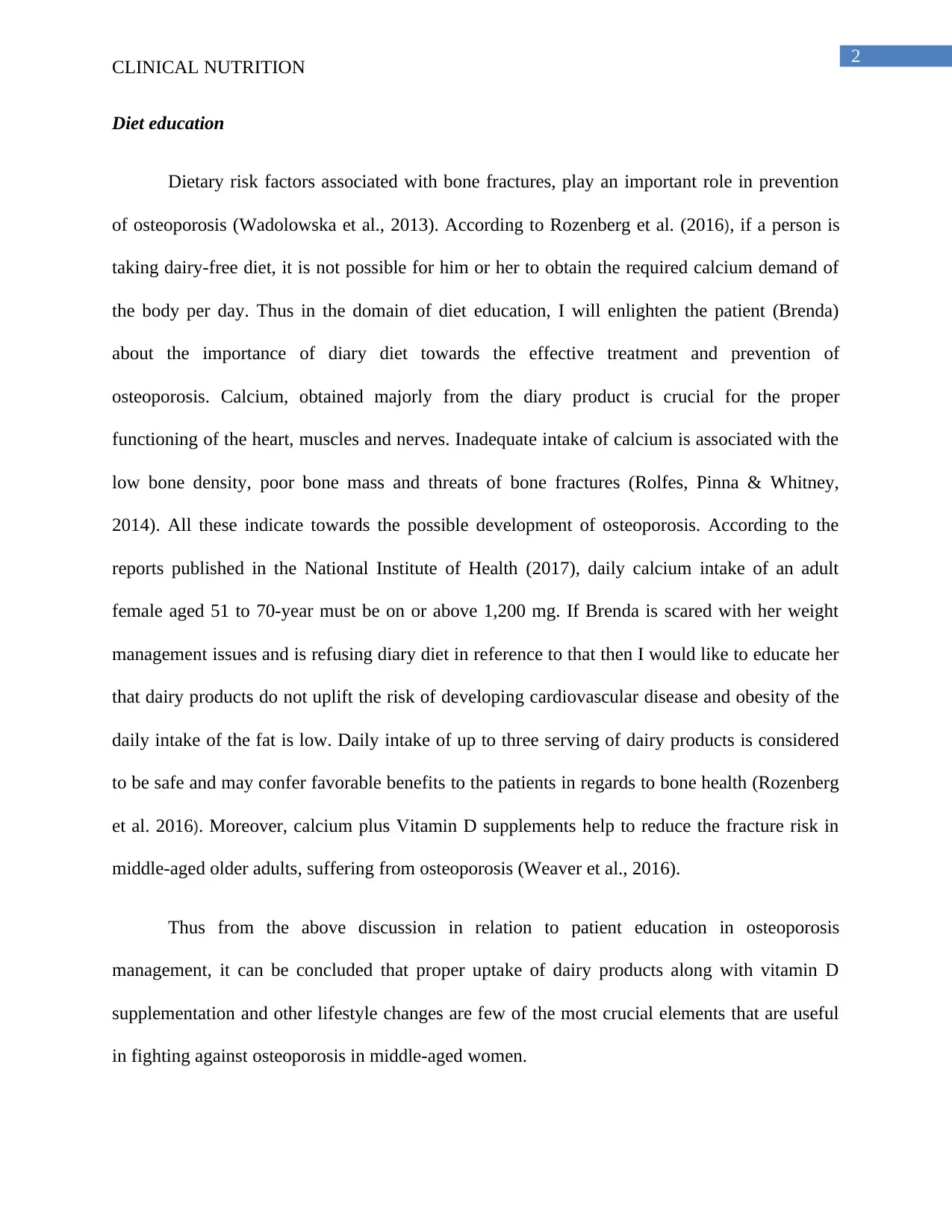
2
CLINICAL NUTRITION
Diet education
Dietary risk factors associated with bone fractures, play an important role in prevention
of osteoporosis (Wadolowska et al., 2013). According to Rozenberg et al. (2016), if a person is
taking dairy-free diet, it is not possible for him or her to obtain the required calcium demand of
the body per day. Thus in the domain of diet education, I will enlighten the patient (Brenda)
about the importance of diary diet towards the effective treatment and prevention of
osteoporosis. Calcium, obtained majorly from the diary product is crucial for the proper
functioning of the heart, muscles and nerves. Inadequate intake of calcium is associated with the
low bone density, poor bone mass and threats of bone fractures (Rolfes, Pinna & Whitney,
2014). All these indicate towards the possible development of osteoporosis. According to the
reports published in the National Institute of Health (2017), daily calcium intake of an adult
female aged 51 to 70-year must be on or above 1,200 mg. If Brenda is scared with her weight
management issues and is refusing diary diet in reference to that then I would like to educate her
that dairy products do not uplift the risk of developing cardiovascular disease and obesity of the
daily intake of the fat is low. Daily intake of up to three serving of dairy products is considered
to be safe and may confer favorable benefits to the patients in regards to bone health (Rozenberg
et al. 2016). Moreover, calcium plus Vitamin D supplements help to reduce the fracture risk in
middle-aged older adults, suffering from osteoporosis (Weaver et al., 2016).
Thus from the above discussion in relation to patient education in osteoporosis
management, it can be concluded that proper uptake of dairy products along with vitamin D
supplementation and other lifestyle changes are few of the most crucial elements that are useful
in fighting against osteoporosis in middle-aged women.
CLINICAL NUTRITION
Diet education
Dietary risk factors associated with bone fractures, play an important role in prevention
of osteoporosis (Wadolowska et al., 2013). According to Rozenberg et al. (2016), if a person is
taking dairy-free diet, it is not possible for him or her to obtain the required calcium demand of
the body per day. Thus in the domain of diet education, I will enlighten the patient (Brenda)
about the importance of diary diet towards the effective treatment and prevention of
osteoporosis. Calcium, obtained majorly from the diary product is crucial for the proper
functioning of the heart, muscles and nerves. Inadequate intake of calcium is associated with the
low bone density, poor bone mass and threats of bone fractures (Rolfes, Pinna & Whitney,
2014). All these indicate towards the possible development of osteoporosis. According to the
reports published in the National Institute of Health (2017), daily calcium intake of an adult
female aged 51 to 70-year must be on or above 1,200 mg. If Brenda is scared with her weight
management issues and is refusing diary diet in reference to that then I would like to educate her
that dairy products do not uplift the risk of developing cardiovascular disease and obesity of the
daily intake of the fat is low. Daily intake of up to three serving of dairy products is considered
to be safe and may confer favorable benefits to the patients in regards to bone health (Rozenberg
et al. 2016). Moreover, calcium plus Vitamin D supplements help to reduce the fracture risk in
middle-aged older adults, suffering from osteoporosis (Weaver et al., 2016).
Thus from the above discussion in relation to patient education in osteoporosis
management, it can be concluded that proper uptake of dairy products along with vitamin D
supplementation and other lifestyle changes are few of the most crucial elements that are useful
in fighting against osteoporosis in middle-aged women.
⊘ This is a preview!⊘
Do you want full access?
Subscribe today to unlock all pages.

Trusted by 1+ million students worldwide
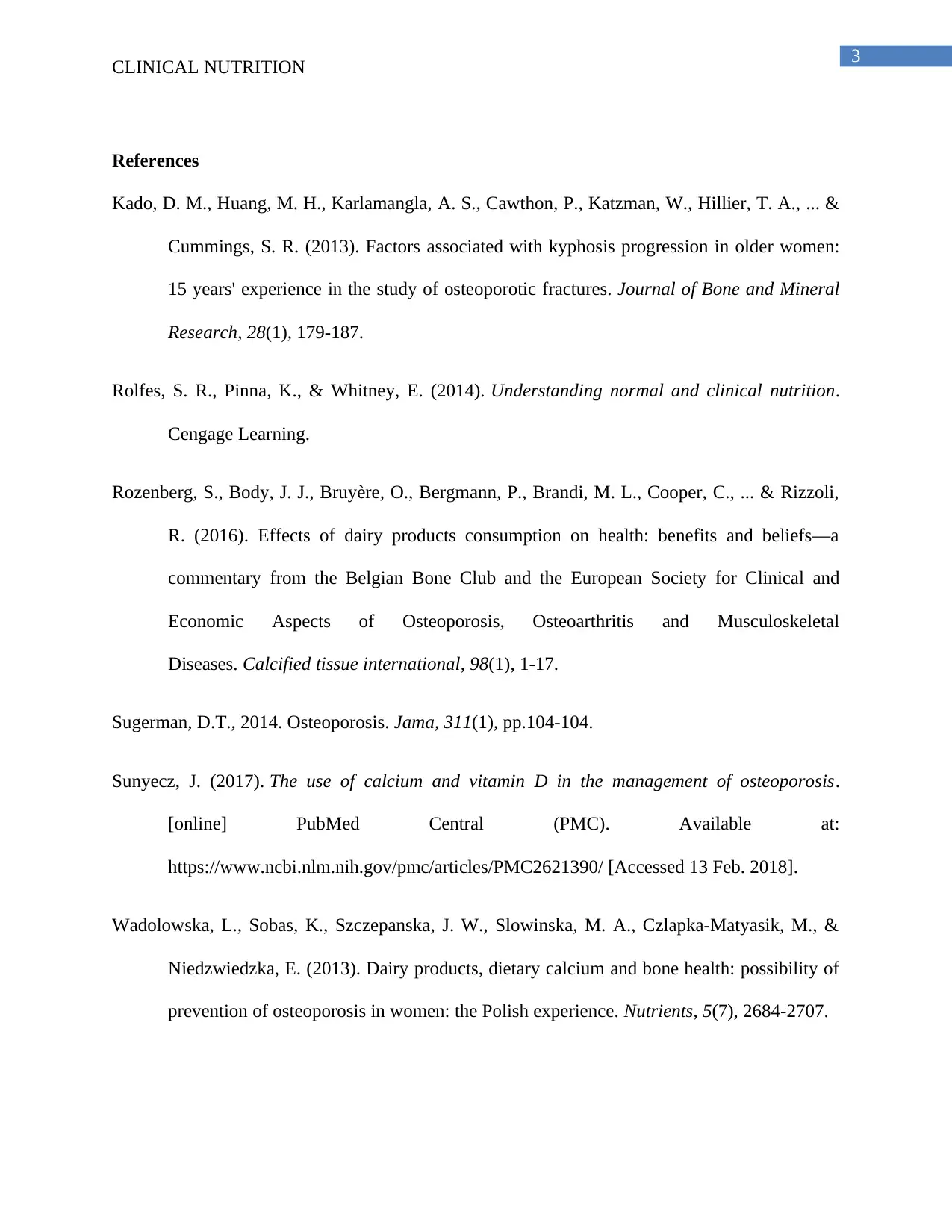
3
CLINICAL NUTRITION
References
Kado, D. M., Huang, M. H., Karlamangla, A. S., Cawthon, P., Katzman, W., Hillier, T. A., ... &
Cummings, S. R. (2013). Factors associated with kyphosis progression in older women:
15 years' experience in the study of osteoporotic fractures. Journal of Bone and Mineral
Research, 28(1), 179-187.
Rolfes, S. R., Pinna, K., & Whitney, E. (2014). Understanding normal and clinical nutrition.
Cengage Learning.
Rozenberg, S., Body, J. J., Bruyère, O., Bergmann, P., Brandi, M. L., Cooper, C., ... & Rizzoli,
R. (2016). Effects of dairy products consumption on health: benefits and beliefs—a
commentary from the Belgian Bone Club and the European Society for Clinical and
Economic Aspects of Osteoporosis, Osteoarthritis and Musculoskeletal
Diseases. Calcified tissue international, 98(1), 1-17.
Sugerman, D.T., 2014. Osteoporosis. Jama, 311(1), pp.104-104.
Sunyecz, J. (2017). The use of calcium and vitamin D in the management of osteoporosis.
[online] PubMed Central (PMC). Available at:
https://www.ncbi.nlm.nih.gov/pmc/articles/PMC2621390/ [Accessed 13 Feb. 2018].
Wadolowska, L., Sobas, K., Szczepanska, J. W., Slowinska, M. A., Czlapka-Matyasik, M., &
Niedzwiedzka, E. (2013). Dairy products, dietary calcium and bone health: possibility of
prevention of osteoporosis in women: the Polish experience. Nutrients, 5(7), 2684-2707.
CLINICAL NUTRITION
References
Kado, D. M., Huang, M. H., Karlamangla, A. S., Cawthon, P., Katzman, W., Hillier, T. A., ... &
Cummings, S. R. (2013). Factors associated with kyphosis progression in older women:
15 years' experience in the study of osteoporotic fractures. Journal of Bone and Mineral
Research, 28(1), 179-187.
Rolfes, S. R., Pinna, K., & Whitney, E. (2014). Understanding normal and clinical nutrition.
Cengage Learning.
Rozenberg, S., Body, J. J., Bruyère, O., Bergmann, P., Brandi, M. L., Cooper, C., ... & Rizzoli,
R. (2016). Effects of dairy products consumption on health: benefits and beliefs—a
commentary from the Belgian Bone Club and the European Society for Clinical and
Economic Aspects of Osteoporosis, Osteoarthritis and Musculoskeletal
Diseases. Calcified tissue international, 98(1), 1-17.
Sugerman, D.T., 2014. Osteoporosis. Jama, 311(1), pp.104-104.
Sunyecz, J. (2017). The use of calcium and vitamin D in the management of osteoporosis.
[online] PubMed Central (PMC). Available at:
https://www.ncbi.nlm.nih.gov/pmc/articles/PMC2621390/ [Accessed 13 Feb. 2018].
Wadolowska, L., Sobas, K., Szczepanska, J. W., Slowinska, M. A., Czlapka-Matyasik, M., &
Niedzwiedzka, E. (2013). Dairy products, dietary calcium and bone health: possibility of
prevention of osteoporosis in women: the Polish experience. Nutrients, 5(7), 2684-2707.
Paraphrase This Document
Need a fresh take? Get an instant paraphrase of this document with our AI Paraphraser
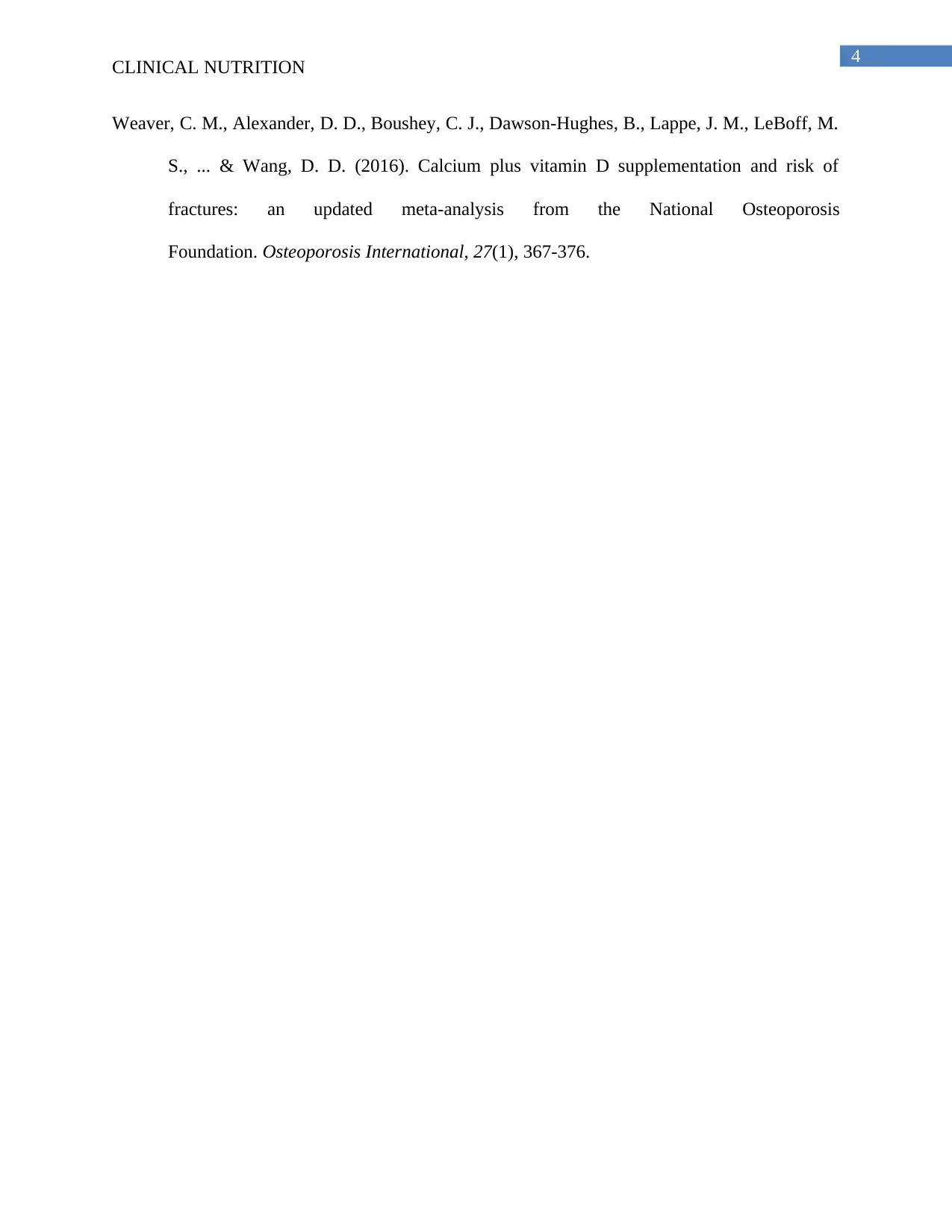
4
CLINICAL NUTRITION
Weaver, C. M., Alexander, D. D., Boushey, C. J., Dawson-Hughes, B., Lappe, J. M., LeBoff, M.
S., ... & Wang, D. D. (2016). Calcium plus vitamin D supplementation and risk of
fractures: an updated meta-analysis from the National Osteoporosis
Foundation. Osteoporosis International, 27(1), 367-376.
CLINICAL NUTRITION
Weaver, C. M., Alexander, D. D., Boushey, C. J., Dawson-Hughes, B., Lappe, J. M., LeBoff, M.
S., ... & Wang, D. D. (2016). Calcium plus vitamin D supplementation and risk of
fractures: an updated meta-analysis from the National Osteoporosis
Foundation. Osteoporosis International, 27(1), 367-376.
1 out of 5
Related Documents
Your All-in-One AI-Powered Toolkit for Academic Success.
+13062052269
info@desklib.com
Available 24*7 on WhatsApp / Email
![[object Object]](/_next/static/media/star-bottom.7253800d.svg)
Unlock your academic potential
Copyright © 2020–2025 A2Z Services. All Rights Reserved. Developed and managed by ZUCOL.





